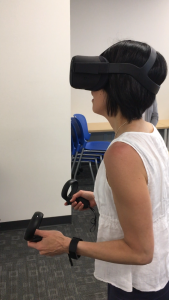On June 15, 2019, we—along with the JGCC’s Deputy Director and Head of Research Lori Takeuchi and foundry10’s Co-founder and CEO Lisa Castaneda—convened a group of experts at the Interaction Design and Children (IDC) conference in Boise, Idaho to participate in a one-day workshop on kids and immersive media. At this workshop, we focused on how to ensure immersive media—or augmented reality (AR), virtual reality (VR), and mixed reality (MR)—for kids is designed responsibly by taking into account kids’ developmental needs, equity, and inclusivity.
Building off the Future of Childhood Salon on Immersive Media and Child Development last November, we joined together at IDC to continue to be proactive about design in this area. This is important because immersive media, despite some industry recommendations that they not be used by kids under 13, are already growing quickly in popularity for children of all ages. And, whether experienced through head-mounted displays like Oculus Quest or Google Cardboard, a typical smartphone, or special systems like Osmo, these immersive experiences present exciting opportunities for learning, creativity, exploration, health and well-being, access, empowerment, and more, while at the same time raising concerns for how using immersive technologies may adversely affect kids’ physical, cognitive, and socio-emotional development. Expanding where children can “go” and what they can “do” beyond what is possible in the physical, unmediated world in extremely realistic ways, these technologies are different from other types of technologies and media. Therefore, we need to get ahead of the curve by reflecting on what we know now to ensure that kids can engage with immersive media productively and safely in the future.
This year’s IDC was a great place to do this work. With the conference theme “Live Healthy: Design, Create, and Explore,” it featured a wide variety of relevant work, including papers about mixed reality technology designed for and by children (see MaR-T: Designing a Projection Based Mixed Reality System for Nonsymbolic Math Development of Preschoolers and “I’m Drowning in Squirrels!”: How Children Embody and Debug Computational Algorithms Through Designing Mixed Reality Games), as well as a panel discussion about current ethical concerns in interactive design for children and a workshop on including children with special needs in the design process. By getting together at this design-centered conference, we hoped to focus on using our collective experiences, research, and knowledge of the field to begin to develop recommendations for the design and development of AR, VR, and MR for kids.

Our twelve workshop participants included researchers and designers from academia, nonprofits, and industry. They brought perspectives from public health, mental health, teaching and learning, participatory design, technology/software design and development, and more; and they offered expertise on children of all ages (3 years up to 18 years and beyond). Importantly, all of these participants consider issues of equity and inclusion as key threads in their work.
In terms of programming, our workshop started with a short game and introductions to share our unique backgrounds. Next we tackled an initial discussion to untangle differences, affordances, and limitations of the different forms of immersive media along various dimensions (e.g., social, psychological, and physical considerations, what types of learning each is best suited for, etc.). For example, one group discussed how virtual reality can give children the feeling of traveling to a place they could never visit in real life, whereas augmented reality might allow them to learn new things about objects in their everyday environment. Through this conversation, we also found that the definitions of AR, MR, and VR across our various fields were not always so clear cut, making our untangling even more difficult. Then, small groups met throughout the rest of the day to brainstorm and generate design recommendations based on these different potentials and challenges.
Through our discussions, we generated some initial design recommendations, including:
- Design for collaboration between and among children, adults, teachers, etc.
- Include easy exit pathways for children to quickly stop an experience or remove a device if needed
- Create ways for children to preview content before experiencing it
- Allow for agency and exploration
A few key questions we encountered were:
- Can design recommendations cover all types of immersive media together, or is there a need to be more specific? (Similarly, the XR Association has created a developer’s guide for VR and AR but doesn’t focus on children.)
- How can cultural relevance, socioeconomic diversity, and accessibility and inclusion all be considered? (Since our workshop, the XR Access community has started tackling immersive media and accessibility!)
- What new research do we need to do vs. what can we glean from already conducted research on immersive media (with and without kids) and on other technologies for kids?
After this productive day, we are excited to move forward in our creation of recommendations for immersive media designers and developers. Our next step includes engaging additional stakeholders, primarily industry designers, but also parents and families, pediatricians, and other experts who were not part of this first workshop. With their guidance, we will create a report to share on the responsible design of immersive media for kids. We look forward to sharing this work in 2020!
For more information about this workshop, you can read our workshop proposal in the Association for Computing Machinery Digital Library and check out our website for updates.
 Sam Bindman is a research psychologist who studied Psychology at Grinnell College and earned her PhD in Developmental Psychology from the University of Michigan, where she spearheaded innovative research using voice recorders to study parent-child conversations at home. Sam’s current projects include exploring the potential for Virtual Reality to foster learning for students of all ages both in and out of the classroom, the promise of dramatic arts for engaging young children in learning, and the role of technology in family life for both young children and youth learning to navigate the digital world.
Sam Bindman is a research psychologist who studied Psychology at Grinnell College and earned her PhD in Developmental Psychology from the University of Michigan, where she spearheaded innovative research using voice recorders to study parent-child conversations at home. Sam’s current projects include exploring the potential for Virtual Reality to foster learning for students of all ages both in and out of the classroom, the promise of dramatic arts for engaging young children in learning, and the role of technology in family life for both young children and youth learning to navigate the digital world.
 Kiley Sobel is a Research Scientist at the Joan Ganz Cooney Center at Sesame Workshop. Currently, she focuses on the responsible, inclusive, and equitable design of and standards for emerging technologies and new media for children to ensure that we positively impact the future of childhood. Prior to the Cooney Center, Kiley completed her PhD in Human Centered Design & Engineering at the University of Washington as a National Science Foundation Graduate Research Fellow.
Kiley Sobel is a Research Scientist at the Joan Ganz Cooney Center at Sesame Workshop. Currently, she focuses on the responsible, inclusive, and equitable design of and standards for emerging technologies and new media for children to ensure that we positively impact the future of childhood. Prior to the Cooney Center, Kiley completed her PhD in Human Centered Design & Engineering at the University of Washington as a National Science Foundation Graduate Research Fellow.

